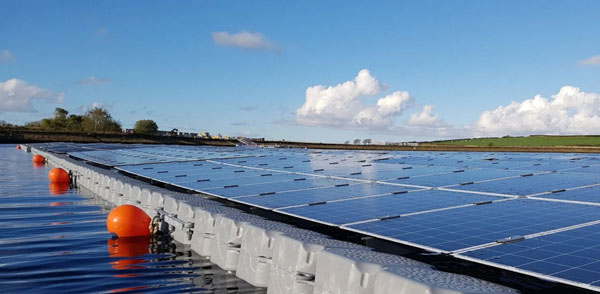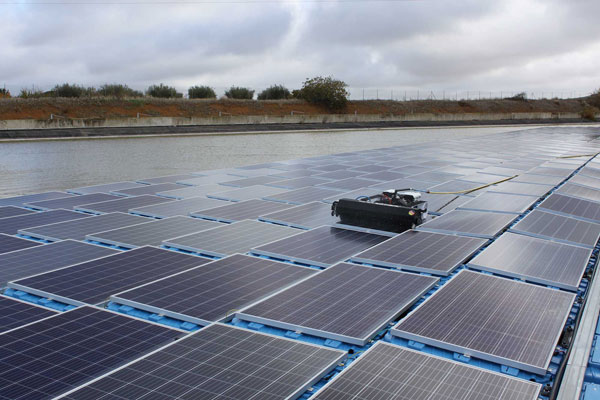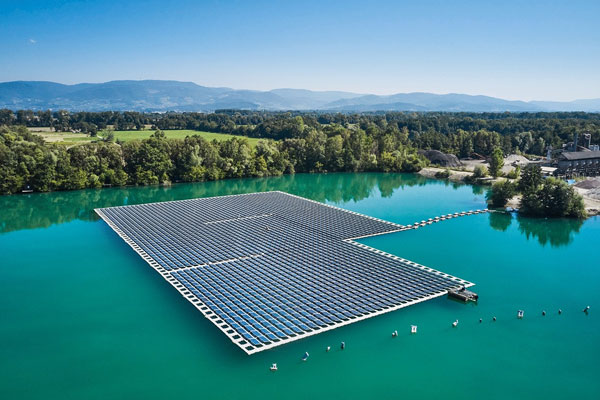Site Selection and Design
Choosing a suitable site for floating solar photovoltaic installation is crucial to ensure maximum energy efficiency and minimal negative impact on the environment. Among the principal parameters that should be considered are solar irradiance, water body conditions, and the surrounding biotic community. For instance, a floating PV installation in California or Florida will ensure higher energy output due to high solar irradiance. Besides, it is important to analyze long-term data to predict the available solar energy. In addition, floating PV systems should be designed to minimize shading from other panels and light reflection and use an adjustable tilt angle to maximize incident solar rays throughout the year. For example, a 5% increase in power was observed in a similar experiment on a floating PV system installed in Napa, California, when tilt angles were adjusted seasonally.
Selection of Materials
Material selection can ensure long-term efficiency and lifespan of floating solar panels and the system as a whole. Since in-water devices are exposed to UV rays, moisture, and temperature changes, the vendors should select durable materials. For example, high-density polyethylene is used for flotation devices due to its durability and resistance to photo-degradation. In one study conducted in Japan, the degradation levels of a floating PV system accounting for the performed UV tests had demonstrated only 0.5% degradation in buoyancy and overall integrity over a 10-year lifespan.
Integration of Energy Storage
Energy storage solutions, such as lithium-ion batteries or flow batteries, can enhance the performance of floating PV systems due to the minimization of the impact of solar energy intermittency. For instance, in the floating PV project located in South Korea, the 500 kWh battery system integrated into the grid to prevent large-scale solarizing and stabilize the provided energy.
Environmental Concerns
The consideration of potential adverse impacts on the environment is mandatory. On the one hand, it can reduce water evaporation. On the other hand, as all types of human activity, the installation and operation of floating PV systems impact aquatic life by blocking sunlight. Transparent PV panels can partially mitigate the impact. For example, they are used in pilot projects to implement transparent or semi-transparent PV panels, ensuring that light can penetrate through them to ensure appropriate photosynthesis and sufficient sunlight for life in water. Since the water covers 70% of the Earth’s surface, the success of such a solar installation can greatly improve the electricity generation capacity in comparison with roofed counterparts. On the other hand, bifacial solar panels are a superior option to monofacial ones, which have been used in 1 MW installation in Singapore. Since switches to bifacial solar panels have shown a 10% increase in energy output, the provided image can reflect only a minimal proportion of the efficiency of solar panels listed in the source.

Material Innovations
In the domain of floating solar photovoltaic systems, material innovations are considered to be crucial developments to improve the durability, performance, and environmental friendliness of the technology. With numerous manufacturers and researchers concentrating on this area, a variety of materials are being produced that can perform well in aquatic environments and influence the functioning of the solar panels positively.
Advanced Coatings
Solar panels are increasingly equipped with innovative hydrophobic coatings to prevent water from accumulating on the surface of the panel. This decreases the potential for soiling and sustains the maximum energy absorption for the panels. For instance, on Chesapeake Bay, the solar panels used nano-coating technology. The panels with the coating maintained 3% higher efficiency rates than uncoated technology throughout the year of operation.
High-Performance Floating Structures
The development of high-performance floating structures is crucial for the sustainability of floating PV systems. Innovative materials such as reinforced polymer composites are used to manufacture floats that present higher UV resistance and decrease the degradation of the system. When the R&D project was conducted in Lake Mead, Nevada, the fiberglass-reinforced polymer floats showed less than 1% of degradation in buoyancy and structure over five years.
Eco-Friendly Materials
Currently, the emphasis on the use of floating PV systems is on environmental sustainability. Biodegradable floats out of plant-derived plastics are also tested in several pilot projects around the world. In the case of the Netherlands, it was demonstrated that the biodegradable floats performed the same as regular floats in aquatic environments; however, they degraded quickly without affecting water quality and aquatic life.
Lightweight and Flexible Systems
Lightweight and flexible systems are developed to minimize the excessive weight on floats and make solar panels adaptable to various aquatic environments. The ultra-lightweight flexible panels used in the project in the Amazon basin automatically landed on the exact optimum angle for energy absorption after 20-45 minutes of moving with changing water levels approximately 4-5 times a year.
Installation Methods
It is crucial to optimize the installation methods of floating solar photovoltaic systems to enhance their efficiency and durability. Several advanced techniques and equipment ensure that such systems are effectively installed and maintained properly.
Modular Installation Approach
The modular installation approach is among the major techniques that revolutionize the setup of the contrasted systems. This method implies the pre-attachment of the solar panels and floating structure onshore and then placing the ready components on the water and connecting them. Such installation reduces the duration and expenses. For example, one floating solar farm in Florida of considerable size was constructed in this way, achieving the operational availability approximately 40 percent earlier than in comparison to a standard method.
Automated Alignment Systems
Automated alignment systems are utilized in the process of installation in order to ensure optimal exposure to the sun. The orientation is adjusted throughout the day to assure the precise direction toward the sun’s position at different times, which results in the absorption of the maximum amount of solar energy. A floating PV project in Japan modified the standard approach by integrating GPS and motorized floats, which rotational movement improved the yield by approximately 8 percent .
Anchor Positioning Technology
Anchor positioning technology is crucial for the effective installation and operation of floating solar systems. The technology contributes to the positioning of the installation in the predetermined place. Computer-aided design and GPS measurements help place the anchors in such a way as to balance all the forces that affect the solar system. In the case of a project in Switzerland at the Lake Zurich, the technology employed was used to ensure minimal movement and, therefore, the optimal exposure to the sun and reduced wear-out of components.
Impact-Resistant Designs
Impact-resistant designs guarantee that the floating installations can cope with different debris and damage related to weather. These include special types of glass and design of the components that secure their integrity for the longest possible time. For example, within the unique floating solar farm in Texas, the impact-resistant panels that managed to stay sustained during a Category 4 hurricane have been used.
Monitoring and Maintenance Protocols
It is vital that floating solar PV systems continue to work efficiently over time. To this end, we have developed detailed protocols and tools that help us identify and repair problematic areas at an early stage. On-site monitoring systems have been introduced, which continuously evaluate the performance of the systems. They use sensors located on the floating PV and the surrounding soil to measure various parameters, such as solar irradiance, panel temperature, and energy output. The floating PV installation in California, for example, is equipped with smart sensors that monitor the system every 15 minutes and inform operators quickly when the performance drops, which is a sign that maintenance is needed.
Use of drones to that end
Drones have already been introduced to monitor floating PV systems. Since the PVs are installed in a large body of water, maintenance and repair teams have been taking boats for days to make the necessary repairs. Meanwhile, drones allow maintenance staff to detect dirty or damaged panels without even having to get into the water. Both sails have been using drones equipped with high-resolution cameras and thermal images for this purpose every two months, which entails no cost savings to staff. The solar PV installation in Arizona conducts frequent maintenance checks every two months, which leads to a savings of 20% over the cost of sending a person to inspect and repair the installation.
Use of on-site monitoring and drones to that end
The efficiency of floating PV systems tends to increase if operators are able to predict in advance when the system is likely to fail. There is a project in Singapore that uses machine learning models that examine both real-time and historical data, so that they are able to predict exactly when the floating PV needs to be repaired. The models are trained to analyse the available data and information, which is then used to develop maintenance schedules for the floating PV operator. Thanks to the advanced algorithms, the entire cleaning of the floating PV in one Singaporereservoir lasted less time, at 2 hours.

Data Analysis Techniques
Data analysis is vital to the optimization of performance and reliability of floating solar photovoltaic (PV) systems. Advanced techniques enable processing and interpretation of large amounts of data, leading to insights that can be acted upon to enhance efficiency and operations.
Advanced Statistical Modeling
Advanced statistical modeling is critical in the understanding and prediction of a variety of performance variables related to floating PV systems. These models can be used to establish various trends and anomalies and understand correlations between a range of operational parameters. For instance, a solar farm in Nevada used regression models to predict output based on data regarding historical weather, solar irradiance, and other factors . This allows for subsequent integration into the grid and planning of power supplies.
Machine Learning Algorithms
Machine learning algorithms are frequently used to enhance the output of energy and predict maintenance requirements. For example, neural networks and decision trees analyze real-time data to predict downtime and efficiency slowdowns. In South Korea, floating solar has been utilized to adjust the orientation of panels throughout the day, leading to an increase in energy output by 12% .
Geographic Information Systems (GIS)
Geographic Information Systems (GIS) have been used to study sites and monitor these installations after they have been implemented. GIS tools are used to map the optimal site layout for the solar panels and analyze the various attributes to monitor the surrounding areas for fluctuations. For example, a project in Australia uses GIS to monitor the sediment in various bodies of water under its arrays that could potentially damage the panels .
Time-Series Analysis
Time-series analysis is critical for the monitoring of the data streams from solar PVs. This is necessary to predict seasonal trends and deterioration of the panels. For instance, in Japan, floating solar is employing time-series modeling to predict panel replacements that will result in performance loss before the drop of efficiency in panels becomes significant.
Sustainability Practices
Deploy and operationalize of floating solar panels photo voltaic demands sustainability practice. The sustainability practice are of both environmental protection and a social economic benefit to the renewable energy project.
Eco-friendly material use
The use of eco-friendly material in the construction and maintenance of the floating solar panels is a key sustainability practice. Eco-friendly materials are those which are of low to no destruction to the environment. The materials selected to utilize the system in activity or when not in operation. A big floating photo voltaic system in Germany has its floats made of 100% recycled high density polyethylene. Using recycled polyethylene the carbon dioxide emission is 70% less than using new plastics. The floats are durable and easy to maintain.
Water quality management
For edible floating panels, it is vital to maintain high medium water quality across the floating system. Water quality management includes measuring, monitoring and treating the water bodies on which the solar panels are placed which can be used either for agriculture or domestic use supply. Water quality of a water pool alter when metallic or any chemical which can dissolve is introduced to that water. Various equipment are set up to measure water quality on 24 hour cycle. Data like p.h, temperature, oxygen level, turbidity among others are monitored. An automatic monitoring stations are included as a part of the installation to provide real time readings to a central monitoring table, for prompt measures taken if the water quality density drifts form the safety standard of water quality.
Biodiversity enhancement initiative
The floating solar panels raise different initiatives on how to enhance the biodiversity of the surroundings other than destroying they existing biodiversity. Over a 10km x 8 km size of water surface solar panels uses 1% surface area, other than disrupting the natural biodiversity species, the project enhances the coral biodiversity of south east asia by growing corals urement and breeding fish underwater. The project is in Singapore where the solar panels project uses 60% of the water surface in ways that benefits all biodiversity thereby there is no destruction of the biodiversities on the water other than enhancing them.
Community development practice
This is a practice employing the local community and support the regions developments. The two practices are the passive socio-economic benefit. The two practices helps to contribute a region with: jobs opportunities, studies in renewable energy sector, upgrading local infrastructure, mostly electricity and access roadways, community financing at low independent interest. A solar panels project in California, United States of America contribute 10% of its gross profit to finance scholarship for students studying environmental science with the main course in renewable energy in the region.



